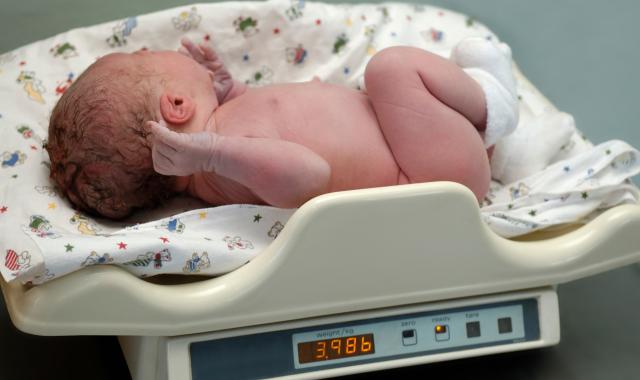Taking the worry out of having your breastfed baby weighed

Most babies are measured and weighed many times in their early years. These checks can help you know if your baby is healthy and growing well.
Patterns of weight gain and growth for breastfed babies
All babies are different, but breastfed babies typically:
- lose up to 10% of their birth weight in the first week
- regain their birth weight by 2 weeks
- grow more slowly after the first 3 to 4 months
- double their birth weight by 4 months.
Weight gains can vary from week to week. Looking at average weight gain over a month is often more helpful. Also consider your baby's length, head circumference and overall health. Sometimes a baby may gain less weight but grow more in length.
These are just general guidelines. If you have concerns, speak to your doctor or child health nurse.
Weight gain slows over time
After the first few months, babies may gain weight more slowly. This is normal. Here are some important things to know about how breastfed babies grow:
- In the first 3 months, breastfed babies usually gain weight a bit faster than formula-fed babies.
- From 3 to 4 months onwards, their weight gain slows compared to formula-fed babies. This means there’s probably no need to worry if your 4-month-old baby is no longer gaining weight as quickly as they were.
- Healthy breastfed babies usually weigh less than formula fed babies at one year.
Growth charts
World Health Organization (WHO) growth charts are based on the length and weight of healthy breastfed babies. You can find these charts in your baby health record book. These charts show how your baby grows compared with other babies. Other growth charts may be less useful.
When looking at the growth charts, remember that the 50th percentile on the chart is an average, not a ‘pass’ mark or something to aim for or beat. It simply means that 50% of babies will be below that line and 50% above.
Commonly asked questions about weight gains
If you’re worried about weight gain, you may also worry about milk supply. There are some reliable signs that your baby is getting enough.
Sometimes, babies have trouble removing milk, which can affect supply. If you’re concerned, seek support from an ABA breastfeeding counsellor, child health nurse, or lactation consultant.
This isn’t always a sign of a problem. Weight gains of breastfed babies usually slow down around 3 to 4 months.
If you're worried about your baby's weight you could offer extra breastfeeds while seeking support.
Here are some other possible causes to think about.
- Is your baby feeding often enough? In the first few months, most babies need at least 8 to 14 feeds in 24 hours.
- Are you offering both breasts at each feed? Some babies start off just needing one breast but may need both as time goes on.
- Has your baby been feeding less recently, perhaps because they are sleeping longer at night? An extra feed during the day may help.
- Are you feeding at set times instead of when your baby wants to? They may not be taking as much breastmilk as they were before.
- Is your baby feeding well? Some babies have a poor sucking action, so they don't remove milk from the breast well.
- Have you been extra stressed, unwell or started a new medication? What about hormonal changes? For some mums these can affect supply.
If your baby is underweight but has a good nappy count, there may be a medical reason. Most health problems that affect weight gain can be treated and breastfeeding can continue.
infection (anything from a cold to a urinary infection)
vomiting or frequent posseting can mean a baby does not keep down enough milk to grow
a severe allergy to foods in the mother's diet could be a cause of low weight gain.
Test weighing involves weighing the baby before and after a feed, to work out how much milk they drank. Test weighing is only useful if done at every feed for 24 hours. Weighing after just one feed won’t tell you anything about your supply or how much milk your baby needs across a full day. Counting wet and dirty nappies is often easier.
It’s normal for babies to lose weight in the first few days. They only need small amounts of colostrum, the first milk. If you breastfeed often from birth, your baby will get what they need. Around day 3 or 4 your milk supply increases rapidly. This is sometimes called your milk 'coming in'. As your supply grows, your baby’s weight should start to rise, so they regain their birthweight by about 2 weeks.
If your baby has lost some weight, it’s important to look at the whole picture. For example, a 2-day-old baby who’s lost 10% of their birthweight and is sleepy and not feeding well, will need extra support. A baby who’s lost 10% but is feeding often, may not.
If you are concerned, speak to a health professional. It's okay to seek a second opinion if you're still unsure.
© Australian Breastfeeding Association November 2025
Bertini, G., Breschi, R., Dani, C. (2015). Physiological weight loss chart helps to identify high-risk infants who need breastfeeding support. Acta Paediatrica, 104(10), 1024-1027
Chantry, C. J., Nommsen-Rivers, L. A., Peerson, J. M., Cohen, R. J., & Dewey, K. G. (2011). Excess weight loss in first-born breastfed newborns relates to maternal intrapartum fluid balance. Pediatrics, 127(1), e171–e179.
Eltonsy, S., Blinn, A., Sonier, B., DeRoche, S., Mulaja, A., Hynes, W., Barrieau, A., & Belanger, M. (2017). Intrapartum intravenous fluids for caesarean delivery and newborn weight loss: A retrospective cohort study. BMJ Paediatrics Open, 1(1), e000070.
Giudicelli, M., Hassler, M., Blanc, J., Zakarian, C. & Tosello, B. (2022). Influence of intrapartum maternal fluids on weight loss in breastfed newborns. The Journal of Maternal-Fetal & Neonatal Medicine, 35(4), 692-698.
Grossman, X., Chaudhuri, J.H., Feldman-Winter, L., Merewood, A. (2012). Neonatal weight loss at a US Baby-Friendly Hospital. Journal of the Academy of Nutrition and Dietetics, 112(3), 410-413.
Hirth, R., Weitkamp, T., & Dwivedi, A. (2012). Maternal intravenous fluids and infant weight. Clinical Lactation, 3(2), 59–63.
Jurgelėnė, V., Kuzmickienė, V., & Stonienė, D. (2024). The role of skin-to-skin contact and breastfeeding in the first hour post delivery in reducing excessive weight loss. Children (Basel, Switzerland), 11(2), 232.
Macdonald, P. D., Ross, S. R. M., Grant, L., & Young, D. (2003). Neonatal weight loss in breast and formula fed infants. Archives of Disease in Childhood-Fetal and Neonatal Edition, 88(6), F472-F476.
National Health and Medical Research Council. (2012). Infant feeding guidelines: information for health workers. Australian Government.
Noel-Weiss, J., Courant, G., Woodend, A.K. (2008). Physiological weight loss in the breastfed neonate: A systematic review. Open Medicine, 2(4), e99–e110.
Noel-Weiss, J., Woodend, A.K., Peterson, W.E., Gibb, W., & Groll, D.L. (2011). An observational study of associations among maternal fluids during parturition, neonatal output, and breastfed newborn weight loss. International Breastfeeding Journal, 6, 9.
Tawia, S., & McGuire, L. (2014). Early weight loss and weight gain in healthy, full-term, exclusively-breastfed infants. Breastfeeding Review, 22(1), 31–42.
Watson, J., Hodnett, E., Armson, B. A., Davies, B., & Watt-Watson, J. (2012). A randomized controlled trial of the effect of intrapartum intravenous fluid management on breastfed newborn weight loss. Journal of Obstetric, Gynecologic, and Neonatal Nursing, 41(1), 24–32.
WHO Multicentre Growth Reference Study Group. (2006). WHO Child Growth Standards based on length/height, weight and age. Acta Paediatrica, Supplement, 450, 76-85.







